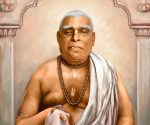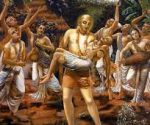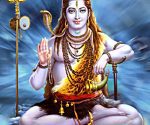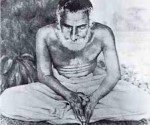Shri Chaitanya Mahaprabhu
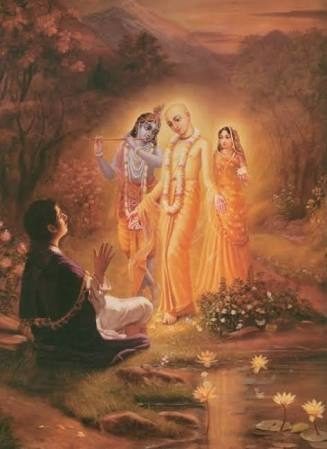 Sri Srimad Bhaktivedanta Narayana Gosvami Maharaja
Sri Srimad Bhaktivedanta Narayana Gosvami Maharaja
Sri Devananda Gaudiya Matha, Navadvipa: March 12, 2000
Sri Caitanya Mahaprabhu appeared in Navadvipa and performed His pastimes there. It is said that after these pastimes were completed, He took sannyasa and went to Puri. Later He went to South India, met Srila Ramananda Raya, and revealed to him His form as Sri Sri Radha and Krsna combined. This form of Rasaraja-mahabhava is also described in the Srimad-Bhagavatam – as the pastimes of Radha and Krsna. Krsna is Rasaraja (the king of all tasters of transcendental mellows) and Radhika is mahabhava-svarupa (the quintessence of transcendental loving emotions towards Krsna).
In Navadvipa, Sri Gauranga performed sakhya-bhava pastimes with His friends in His nara-vat, human-like lila. Some people say that after taking sannyasa in Navadvipa, He left and performed higher pastimes in Puri. After that, on the bank of Godavari He met Ramananda Raya and learned how to taste Krsna in a still more intense mood of separation. It is not actually true, however, that Puri and Godavari are higher than Navadvipa, nor is it true that Sri Sacinandana Gaurahari ever leaves Navadvipa.
It is said that Mahaprabhu was able to taste what He came to this world to taste – only after He met Raya Ramananda, who is Visakha devi in krsna-lila. He learned from him how to taste radha-bhava. Do you know why He learned from Ramananda Raya, instead of Srila Svarupa Damodara, who is Lalita-devi in krsna-lila? Lalita-devi is the first expansion of Radharani and Visakha-devi is the second expansion. But Visakha’s birthday is the same as that of Srimati Radharani, so her nature is the same. She has practically the same qualities and the same form. Krsna could not be taught by Lalita-devi because her mood is pragalba, bold and outspoken. (There is no actual equivalent word in English.) Srimati Radhika and Srimati Visakha, although also left-wing gopis, are the same as each other – madhya-nayika (heroines who are a mixture of pragalbha and mrdvi [sweet and gentle]). Therefore. Mahaprabhu had to learn from Ramananda Raya how to taste radha-bhava. Because it was at Godavari that Mahaprabhu learned to taste that radha-bhava, some say that Godavari is higher than Navadvipa.
But this is not so. Navadvipa itself is the highest abode, and it includes Godavari and Jagannatha Puri. We can understand this by a comparative study of aisvaryamayi-lila and madhuryamayi-lila (“mayi” means consisting of). What is the difference between aisvarya and madhurya? Aisvarya-lila are displays of opulence which cannot be performed by any human being, whereas madhurya-lila are those pastimes which appear human-like, even if there is a great display of opulence. If there is no opulence, activities are simply mundane. So there may be opulence in madhuryamayi-lila, but that lila still appears sweet and human-like, and so it is called madhurya. Whether opulence is clearly present or not, in madhurya-lila there does not seem to be opulence.
As we see from Krsna’s lila, there is more aisvarya in Vrndavana than there is in Vaikuntha, Dvaraka, or Mathura. However, it is covered by so much sweetness that the opulence cannot be tasted. [For clarification an example is given of salt and sugar: There are four cups. The first has 1 ounce of salt and no sugar. The second one has 2 ounces of salt and 2 ounces of sugar. The third has 3 ounces of salt and 6 ounces of sugar. And the fourth has 4 ounces of salt and 100 lbs. of sugar. Although the fourth cup has more salt, one cannot taste it because of all the sugar.] In Goloka Vrndavana the opulence is covered.
Krsna’s madhurya-lila includes aisvarya. When Krsna lifted Govardhana Hill the cowherd boys thought that He must be getting tired. They considered, “We should also help to hold up Govardhana with our sticks.” Others thought, “Because of Nanda Maharaja’s austerities, Lord Narayana had entered Krsna’s body. It is actually Lord Narayana who is holding up Govardhana.” The gopis were glaring upon Govardhana and they said to him, “If you fall down on Krsna, we will curse you.” So these are human-like pastimes. When Krsna was a baby He showed His mother His universal form, and everything was there within His mouth – all incarnations, all universes, all elements, all senses, and so forth. Despite this, however, Yasoda maiya could not conceive that her son is God.
Sri Caitanya Mahaprabhu is Krsna Himself, and His dhama, Sri Navadvipa, is Vrndavana itself. In Navadvipa He was known as Saci-putra and Sacinandana, the son of Saci-mata and Jagannatha Misra. He was also called Visnupriya-pati, the husband of Srimati Visnupriya-devi. Practically no one there knew He was the Supreme Lord. Two of His friends at that time were Jagadananda Pandita and Svarupa Damodara. They were his fellow-students when He attended the school of Gangadasa Pandita, and they all performed their madhurya-lila there. As there are so many human learned scholars or panditas, the residents of Navadvipa considered Saci-putra to be Nimai Pandita, a very good human pandita. There is no aisvarya in this name Nimai Pandita. It is nara-vat. When Kesava Kasmiri, the digvijaya (challenging scholar), came to defeat the panditas of Navadvipa, they decided to make Nimai Pandita their representative. They considered Him to be just a boy. Therefore, if He would lose, they could then say, “He’s just a boy.” And if He would win, they could consider it a great victory for Navadvipa that their boy-scholar was successful.
Being fellow-students in Gangadasa Pandit’s school, Jagadananda Pandita and Nimai Pandita used to have friendly arguments about logic. Sometimes they would argue about the definition of mukti. Jagadananda Pandita would quote the verse beginning, “Atyantya dukha nivritti – Liberation means to be delivered from the miseries of maya.” But Nimai Pandita would say, “No. The real definition of mukti is: ‘Mukti hitva anyata rupam, svarupena vyavastiti – Mukti is that condition in which one realizes his own svarupa and the svarupa of Krsna, and he realizes his relationship with Krsna. Liberation from all false identifications is only possible when one knows his real identification. When one surrenders to the lotus-feet of Radha and Krsna and serves Them with one’s transcendental body and senses, that is mukti. Otherwise mukti is only partial.'” So this is nara-lila – human-like friends arguing together.
In Jagannatha Puri, on the other hand, there were so many opulent pastimes, which everyone knew could not be performed by a human being. For example, when Mahaprabhu jumped in the ocean and was caught in the fisherman’s net, His body became elongated and all His joints were separated by eight inches. This is opulence, and this is very deep and very hard to understand. After Mahaprabhu completed his talks with Ramananda Raya, He tasted the fruits in Gambhira and only three-and-one-half persons were allowed to enter there – Sri Ramananda Raya, Sri Svarupa Damodara, Sikhi Mahiti, and his sister Srimati Madhavi-devi.
Dvaraka is full of opulence. There are so many palaces, elephants, horses, and chariots there. Similarly, in Puri there was so much veneration by all Mahaprabhu’s devotees, and all were fearful to make proposals to Him. In Navadvipa, on the other hand, Kolaveca Sridhar would have arguments with Nimai Pandita – and Nimai would even steal his vegetables.
In Vraja, Sri Krsna is considered an ordinary cowherd-boy. In Navadvipa, Sri Caitanya Mahaprabhu is considered an ordinary brahmana’s son. No one could conceive of Him being called Mahaprabhu in Navadvipa. Only when He went to Puri did He begin to be called Mahaprabhu. In Navadvipa He sucked the breast of Saci-devi. He played with the girls who were worshipping Siva-linga to get a good husband. He also sometimes behaved as a mischievous student. His lila, therefore, is called madhuryamayi-lila. Someone may object to this statement, considering that He manifested as Nrsimhadeva and Varaha in Navadvipa. This is true, but hardly anyone saw this. Practically all the devotees always thought He was simply Saci-putra. Only a few were in the mood of worship, like Murari Gupta (who is Hanuman) or Srivas Pandita (who is Narada Muni), understood Him as the Supreme Lord.
COMPARING THE THREE FEATURES
There is a comparison between the three features of Caitanya Mahaprabhu and the three features of Srimati Radharani. There is an original Radhika, and Her complete and original form is called Vrsabanu-nandini Radhika. She never leaves Vrndavana, and she only feels short-term separation from Krsna – as when He goes cow-herding for a few hours each day. Vrsabanu-nandini Radhika is always experiencing Her nitya-lila or asta-kaliya-lila pastimes with Krsna, which take place twenty-four hours a day – from one early morning to the next. She is actually never separated from Krsna. There is only an abhimana, or self-conception, that They are sometimes separated.
Vrsabhanu-nandini has two manifestations. One is Viyogini Radhika: Radhika feeling separation from Krsna at Uddhava Kyari when Krsna was in Mathura and Dvaraka. Her other manifestation is in Kuruksetra, and that is Samyogini Radhika. It is Samyogini Radha who meets with Krsna in Kuruksetra. Just as Dvarakadisa-Krsna and Mathuresa-Krsna are always within purnatama Vrajendra-nandana Sri Krsna, so these other two manifestations of Vrsabhanu-nandini Radhika are included within Her original form.
Radhika’s full, original form also feels separation, but only at certain times. For example, She may wake up one morning and think, “Oh, what a terrible dream I had. Krsna went to Dvaraka and married so many queens.” Also, now and then some conception comes, “Oh, Krsna had left. No, Krsna is here after all.” That sentiment or conception takes a sthula-murti, tangible form, in prakata-lila.
The three features of Srimati Radhika – Vrsabanu-nandini, Viyogini, and Samyogini – are defined in the Sanat Kumar Samhita. Just as She has three features, Sri Sacinandana Gaurahari has three features. Sri Krsna Caitanya Radha Krsna nahi anya. Mahaprabhu is no one but Radha and Krsna combined.
When Srimati Radhika is speaking to the bumblebee at Udhava Kyari, She is Viyogini Radhika.
madhupa kitava-bandho ma sprsanghrim sapatnyah
kuca-vilulita-mala-kunkuma-smasrubhir naù
vahatu madhu-patis tan-manininam prasadam
yadu-sadasi vidambyam yasya dutas tvam idrk ‘
(Srimad-Bhagavatam,10.47.12)
“O black bee, don’t touch me. I know you are a representative of Krsna from Mathura, and you are trying to make some compromise. But I will never compromise with that Krsna. I know that the red of your whiskers has come from the kunkum which came from the breasts of His beloveds. It was smeared on Krsna’s garland when He embraced them, and then came on your mustaches.”
This mood of transcendental madness is of Viyogini Radhika, and this is compared to Sri Caitanya Mahaprabhu at Puri. Sri Caitanya-caritamrta explains that the mood of Srimati Radhika which was seen by Uddhava was the constant mood of Caitanya Mahaprabhu at Gambhira.
“Vrindavana parityaja na padam ekam gacchati.” Krsna never leaves Vrndavana. Nanda-nandana is always in Vrndavana. Vrsabhanu-nandini also never leaves Vrndavana, and similarly Sacinandana never leaves Navadvipa.
In Godavari, Caitanya Mahaprabhu manifested his Rasaraja-mahabhava svarupa. There in Godavari He discussed all tattvas: rasa-tattva, prema-tattva, and radha-tattva. But who saw this? Only Ramananda Raya. This manifestation of Rasaraja-mahabhava was not an ordinary activity. No one else could have shown Himself as Radha and Krsna. Therefore it is an opulence; therefore is aisvarya, and it is not the highest lila.
Srimati Radhika’s partial moods and forms are included within Her original form, and this is also true with Sri Caitanya Mahaprabhu. In Mahaprabhu’s lila, Puri is like Dvaraka. When He is in Gambhira, He is experiencing Radharani’s separation from Krsna at Dvaraka, in the mood of Viyogini Radhika. When Mahaprabhu is in Godavari, He is like Samyogini Radhika. This aspect of Srimati Radhika meets Krsna at Kuruksetra in order to bring Him back to Vrndavana. These two aspects of Mahaprabhu are included in Navadvipa.
In Jagannatha Puri, no one accepted the names Sacinandana, etc. Everyone there had reverential mood towards Mahaprabhu. Sarvabhauma Bhattacarya realized, “Here is the Supreme Personality of Godhead. I’ve never seen such a person in this world.” Sri Caitanya-caritamrta (Mad. 6. 9-13) states that while examining the body of Sri Caitanya Mahaprabhu, Sarvabhauma saw that His abdomen was not moving and that He was not breathing. Seeing this condition, he became very anxious. He then took a fine cotton swab and put it before Mahaprabhu’s nostrils. When he saw the cotton move very slightly, he became hopeful. Sitting beside Mahaprabhu, he thought, “This is a transcendental ecstatic transformation brought about by love of Krsna.” Upon seeing the sign of suddipta-sattvika bhava, the Bhattacarya could immediately understand the transcendental ecstatic transformation in Mahaprabhu’s body. Such a sign could take place only in the bodies of Krsna’s eternally liberated associates like the gopis, and especially in Srimati Radhika. The Bhattacarya considered, “The uncommon ecstatic symptoms of adhiruddha-bhava are appearing in the body of Mahaprabhu. This is very wonderful! How are they possible in the body of a human being?”
HIDDEN VRNDAVANA
Navadvipa is gupta (hidden) Vrndavana. Although the twelve forests of Vrndavana are hidden in Navadvipa, they are in a different sequence. Srila Bhaktivinoda Thakura has described this as acintya, inconceivable. He has explained that it is the speciality of this dhama. It is hidden and crooked, and so it cannot be exactly in the same sequence. This is the nature of hidden prema.
Radha-kunda is not far from Devananda Gaudiya Matha. Because Govardhana is here, Radha-kunda and Syama-kunda must also be here. My Guru Maharaja, nitya-lila pravista om visnupada paramahamsa Srila Bhakti Prajnana Kesava Gosvami Maharaja has fulfilled the innermost heart’s desire of Srila Bhaktisiddhanta Sarasvati Maharaja and Srila Bhaktivinoda Thakura by establishing this temple in the valley or plain of Govardhana.
Caitanya Mahaprabhu sometimes stayed here and performed pastimes. One pastime, as explained in Sri Caitanya-caritamrta, was when some young girls were making offerings to Siva-linga with fruits, flowers, and other paraphernalia of worship. At that time Nimai Pandita forcibly stole the offerings and told the girls that they should not waste their time worshipping Lord Siva. He said, “I am the Supreme Personality of Godhead. You should worship Me. All the demigods and demigoddesses are My servants. If you do not worship Me, I will curse you to all get ugly, old husbands who already have five wives.” They were all joking in this way, and they did not believe that He was the Supreme.
All the Vrndavana pastimes are there in Navadvipa. Govardhana and Rasa-sthali are present where we are now sitting, in Koladvipa, at the Devananda Gaudiya Matha. Krsna is dancing here with the gopis. One may say that the highest place in Navadvipa is Yogapitha at Mayapura, because that is where Sri Caitanya Mahaprabhu appeared. But actually, Koladvipa is superior. We must consider the siddhanta (conclusive truth). Comparing Navadvipa to Vrndavana, Mathura-Gokula is the place where Krsna appeared. He appeared simultaneously as Lord Vasudeva in Mathura and as a baby in Gokula. But this place in Koladwipa is Govardhana, where Krsna appeared in His original and most complete form, His kaisora form, His Radha-Krsna yugala form. This is also where rasa-lila, the highest pastime, took place. It can be concluded, therefore, that this place is so much higher.
Srila Rupa Gosvami confirms in his Upadesamrta, “The holy place known as Mathura is spiritually superior to Vaikuntha, the transcendental world, because the Lord appeared there. Superior to Mathura-puri is the transcendental forest of Vrndavana, because of Krsna’s rasa-lila pastimes. And superior to the forest of Vrndavana is Govardana Hill, for it was raised by the divine hand of Sri Krsna and was the site of His various loving pastimes. And, above all, the super-excellent Sri Radha-kunda stands supreme, for it is over-flooded with the ambrosial nectarean prema of the Lord of Gokula, Sri Krsna. Where, then, is that intelligent person who is unwilling to serve this divine Radha-kunda, which is situated at the foot of Govardhana Hill?”
AFTER CLASS
After the class, at an informal darsana just outside Srila Narayana Gosvami Maharaja’s room, a disciple questioned, “You said this morning that there was no opulence manifestation in Navadvipa.” But Caitanya Mahaprabhu revealed His Virat-rupa, His universal form, there in Navadvipa.” Srila Maharaja replied, “Yes, but only to a few; to Srivasa Thakura as Narada Muni.”
Another devotee questioned, “You said in class that Jagannatha Puri represents Dvaraka and Godavari represents Kuruksetra. How is Godavari Kuruksetra?” Srila Maharaja replied, “It is not that Godavari is the same as Kuruksetra. This comparison is given because of its display of opulence. When Srimati Radhika first met Krsna at Kuruksetra, She saw so much opulence: horses, chariots and elephants, and Krsna was dressed as an opulent prince. Similarly, when Mahaprabhu manifested His transcendental form as Rasaraja-Mahabhava, this was a great display of opulence. Another thing was that the great happiness Srimati Radhika felt by meeting Krsna in Kuruksetra after such a long time was only momentary. When She realized that Their meeting and relationship could not be the same as it was in Vrndavana, it became a pathetic scene. Similarly, the opulent display of Mahaprabhu’s Rasaraja-Mahabhava form was only revealed for a moment.




